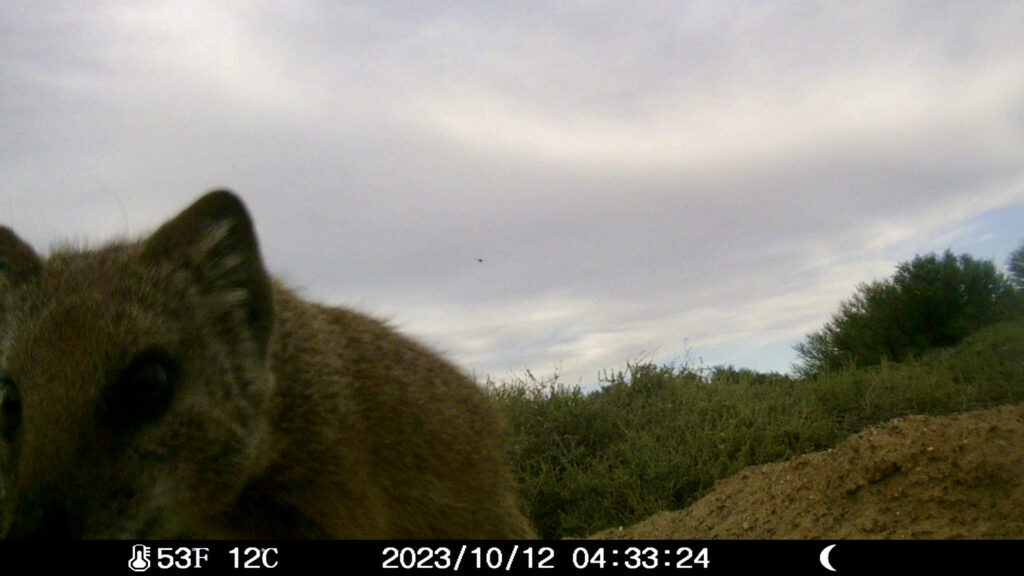
Surviving the Karoo: resilience in a harsh environment
Being a bee on the Karoo plains is challenging. The Karoo is a boom and bust environment with short periods of spectacular productivity and long periods of drought and famine. Plants survive the droughts as seeds in the soil, or as long-lived small shrubs that are able to reduce their water needs to the minimum by discarding leaves, storing water and desisting from flowering and grow for months or years as need be. Nomadism is/was the preferred option for many birds and larger mammals, whereas many reptiles and invertebrates wait out the tough times in underground burrows reducing their activities to the minimum to save energy and water. Populations of small mammals follow boom and bust cycles in unison with the weather with numbers dwindling in drought and growing exponentially in the good times.

A small Apis mellifera capensis swarm two days after rain.

A forager feeding on nectar of ou rambos (Tetraena retrofracta)
Honeybees as cavity dwellers
Honeybee colonies in more stable environments may persist for many years in hollow trees and cavities in rocks. On the Karoo plains there are no trees and rarely any rock cavities. Accommodation, in common with food supply, is ephemeral and honeybees need to be mobile and opportunistic. From the North African deserts comes the 2000 year old biblical tale of the bees that colonised a lion carcass¹. In the Karoo the deep dens and foraging excavations of aardvark offer a somewhat more hygienic place to build a nest – but underground accommodation is temporary and risky.

Apis mellifera capensis nest site on Wolwekraal Nature Reserve near Prince Albert in October 2023 after drought-breaking rains stimulated mass flowering.
Beneath the surface: termites, aardvark and honeybees
Aardvark feed on Harvester Termites which build their nests 1-2 m below the soil surface. The long-snouted aardvark digs down to the nest and uses its sticky tongue to extract its food. Aardvarks eat a portion of the termite workers at night but seldom if ever wipe out the colony. The termites immediately start to repair the damage by filling the aardvark foraging hole with soil and their droppings. Aardvarks also dig deeper, wider burrows or dens in patches of deep soil and use these as a daytime retreat where they sleep. After a few months they move on to find a new source of food, and the abandoned den is quickly occupied by porcupines, bat eared foxes, mongooses, meercats, shell duck or honeybees.

A honeybee dragging out a harvester termite with a dead honeybee attached to it.

Dead worker bee dropped outside the nest with a dead soldier termite that never lets go.

Dead honeybee and harvester termite with a curious ant.
The downsides of making a nest below ground in a termite colony are threefold: flooding during heavy rain, attacks by the termites wishing to reclaim their territory, and unwanted interest from potential predators of termites, particularly Aardvark, Bat-eared Fox, Yellow Mongoose and Meercat. Dealing with these challenges is time consuming and costly for bees. After flooding, the workers clean the mud out of their nest by carrying mudballs out one by one and dumping them above ground. Bees injured or killed by soldier termites need to be carried out of the nest by fellow workers, and unwanted visitors such as mongooses chased away. All this defence and maintenance work reduces the workforce and eats into the time needed to gather the nectar and pollen resources needed to build combs and grow the swarm.

Dead honeybees and soldier termites in the aardvark burrow.
This is probably why the small dark Cape Honey bee (Apis mellifera capensis) with its multiple false-queens, small colonies and mobile lifestyle is much better at exploiting patchy and unpredictable food resources in the Karoo than the larger and more productive yellow race² (Apis mellifera scutellata) from the summer rainfall region of southern Africa.
Camera trap footage from Wolwekraal Nature Reserve taken at the wild honeybee nest site:

Yellow mongoose near bee nest at aardvark burrow.

Bees emerging from the subterranean nest in an aardvark burrow.

Aardvark looking into foraging hole occupied by bees.

Yellow mongoose at bee nest.

Yellow mongoose at bee nest.

A nectar foraging ant at the nest site.
Footnotes

- Lyle’s Golden Syrup tin boasted the now famous logo depicting Samson’s ‘lion and the bees’ (from the Old Testament, Judges 14:8). It was registered as Lyle’s trademark. Just as the bees produce honey inside the lion’s carcass, rich sweet syrup pours forth from the well-loved tin. Apparently the subject was raised at a beekeeper’s meeting in Pretoria – asking why this should be so? One farmer answered that when animals were slaughtered on the farm, honeybees would come and collect the moisture from the carcass (G. Tribe, personal communication, October 25, 2023).
- They are the same species, but from different geographical races of that same species. There are many such geographical races throughout the distribution of Apis mellifera that naturally inhabits Africa, much of Europe, and some of the Middle East.
The author at work:

Dr Sue Milton-Dean has immense experience in plant ecology and veld restoration and dynamics. Sue offers spectacular and highly informative and interesting walks on the Wolwekraal Nature Reserve in Prince Albert. She takes one on a deep-dive into the ecology of the Karoo biome, looking also at its geology, botany, natural and cultural history. For more information visit her website at Wolwekraal Nature Reserve*.
